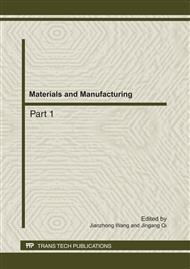p.265
p.269
p.273
p.277
p.282
p.287
p.292
p.298
p.302
Crystal Growth during the Solidification Process of Continuous Casting Slab
Abstract:
Under the condition that the solid-liquid interface bends periodically in continuous casting, the expression of solid-phase growth rate adapting to continuous casting was set up, and then the growth rates were calculated. On this basis, the morphologic of crystal growth and the variation of primary dendrite spacing during continuous casting slabs were studied. The results show that the growth rate is the fastest when solid-phase moves to wave crest within a deformation periodicity, whereas the growth rate is the slowest when the crystal moves to wave hollow. The bigger the bulge size is, the greater the variation amplitude of the growth rate will become. The variation of the growth rate results in the S/L interface to develop towards a planar surface. Because the value is much smaller than the critical value of the transformation from cells to dendrites, and the crystals only grow in the fashion of dendrites. The primary dendrite spacing at wave crest is bigger than the primary dendrite spacing at wave hollow in early stage of columnar crystal growth, and the dendrite spacing at wave crest is basically equal with the dendrite spacing at wave hollow in the late stage of solidification, and they quickly simultaneous increase. Good correlation is obtained between the experimental results and the calculation results of the dendrite arm spacing.
Info:
Periodical:
Pages:
282-286
Citation:
Online since:
July 2011
Authors:
Price:
Сopyright:
© 2011 Trans Tech Publications Ltd. All Rights Reserved
Share:
Citation:


